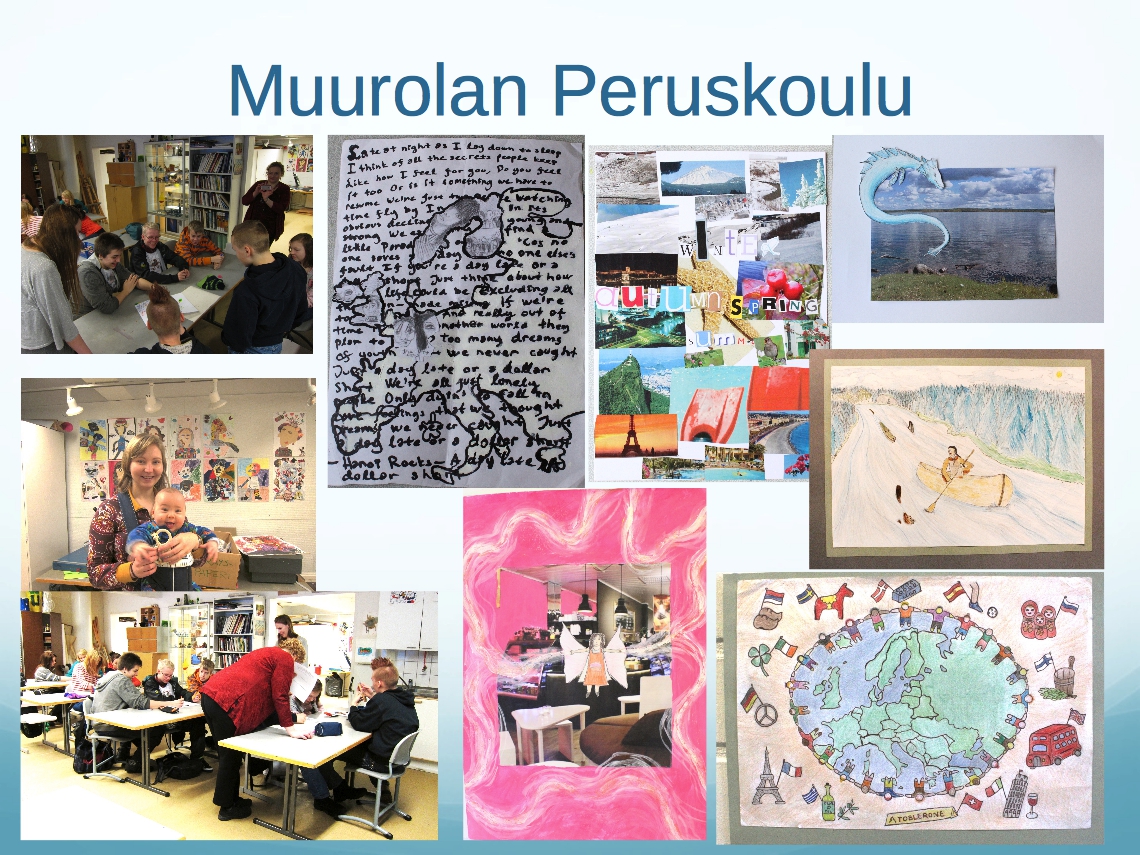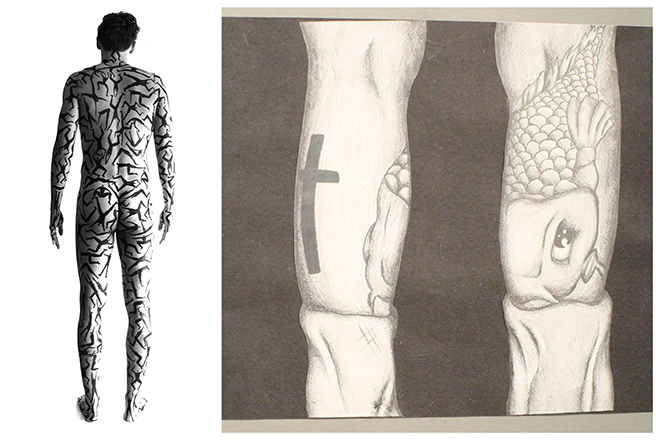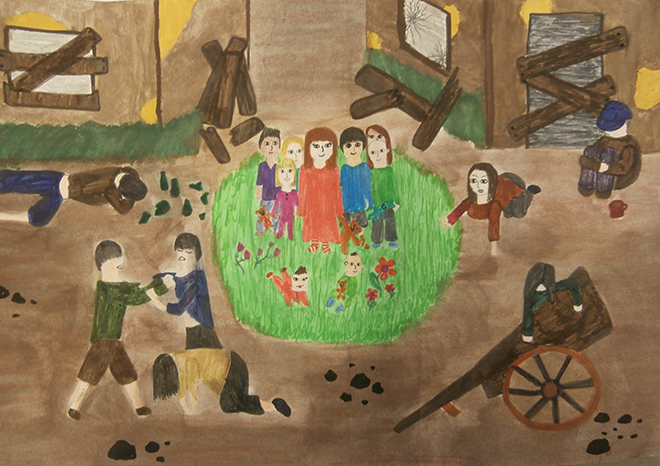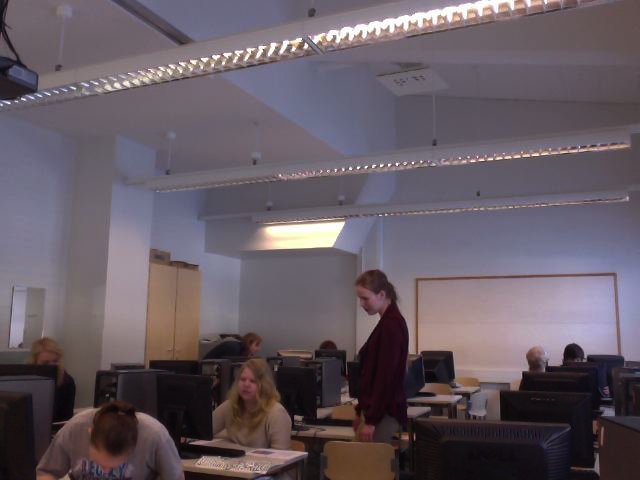Muurolan peruskoulu, Elementary School - Finland
Region: Muurola
Other schools in the Quad Blog: Jesus and Mary Secondary School Gortnor Abbey (Ireland), Chenderit School (UK), Institut Torres i Bages (Spain)
Creative Connections Project: My Europe, My version of an artwork and an imaginative trip to Europe

Muurolan peruskoulu, the elementary school of Muurola, is situated 24 km from Rovaniemi centre in the small town of Muurola. Many of the pupils travel a long distance to the school, from the surrounding villages. The school and the town are situated on the banks of the Kemijoki River. The school centre has a kindergarten, elementary school (primary and secondary levels) and a small upper secondary school working around the same yard and neighbouring buildings. There is also a small library and public health nurse reception in the same group of buildings. Since the schools are small, with around 400 pupils of different ages studying together, many teachers teach several lessons as one community.
A group of 19 students in the 8th grade (14-15-yrs olds) participated in the Creative Connections project who had selected visual art as one of their voluntary subjects. This meant the group was met once a week for two lessons of one and a half hours each.
Interruption of the project
The group had two lessons on Fridays and, because of national holidays, other school projects and happenings; this unfortunately meant that the group lost some of their art lessons. So the project ended up having less time than planned and as a result not everyone finished their work.
15 of 19 pupils posted on the Quad Blog. However, there were a few pupils who did not want to sign up to the agreements at the start of project, since they were told participation in the research was voluntary. They did the same assignments, but their work was not posted on the Creative Connections Quad Blog.
Creative Connections Project
- An imaginative trip to Europe. Warm up assignment in groups.
- My Europe
- Response to an Artwork. Pupils chose an artwork from the Creative Connections Connected Gallery and made their own work inspired by it. They could choose any technique or materials.

- Spirit of a Place. The pupils chose a place important for them and created a fantasy image with the spirit of the place, using a collage technique and a printed photo of the place.
Teacher comment
The Creative Connections project fitted well to the school curriculum's aims for the art lessons. I was especially delighted with the international aspect to contemporary arts and talking about art that the project made possible.
The use of the Connected Gallery
The Connected Gallery was a starting point for one of the main assignments. Researchers introduced the database and the categories for the class at the start of the project. Printed versions of the artwork images were used and spread on the tables. Pupils chose one interesting artwork from the prints and planned their own work inspired by the art piece. The pupils who were confident in their language skills volunteered as translators and made little signs for their shirts so that the others could ask them for help in order to understand the information given about the artworks. The Connected Gallery was also used from the website to connect the original artwork and the pupils’ response in the posts. The other assignment was based on a photograph (of an important place) that the pupil took of her/himself.
Pupil comment:
The artwork assignment was different than what we normally do in art class. It was good to have some starting point, but also a lot of freedom on what kind of work to do as a response.

About Identity and European citizen themes
In small groups the pupils started the project by planning an imaginative trip to Europe and making a mind map of their plan. After getting into the theme they made the My Europe assignment individually. The identity and Europe themes also developed through producing their own versions of the selected artworks from the database. This was possible since the artworks themselves dealt with identity, appearance, language, personal environment, and so on. Thus the pupils had to recognise the artist's background and think about their response to the artwork.
Blogging
The pupils were encouraged and instructed to do the blogging. Several lessons were used during the spring in the computer classroom to concentrate on posting and commenting on the posts from the other pupils on the Quad Blog. For a few of the students it still seemed to be a challenge even to remember their email addresses or login names and passwords. The posting was learned by many quite quickly with help from peers. Most of the pupils did not want to write posts and comments in Finnish, but preferred to write short remarks in English. The online dictionaries were used to help with that. Below is a discussion about this:
Researcher: This text would be also good in the blog, this text also. You could put it there in Finnish.
Pupil: In Finnish?
Researcher: Yes, there's the machine translator, it would be able to translate this.
Pupil: I don't believe it would.

It seemed to be difficult to tell or explain their own works, while the pupils preferred just posting the images. For this reason, one lesson was used to comment on the work of others. As a model exercise everyone had to comment on another posting with a question and respond to a comment made for their post. In this case many of the pupils commented their classmates’ postings. To support this activity the pupils were given a list of questions devised by the Irish team on developing a response to art.
Teacher comment
It would be good to think in future how to develop a more cosy and spontaneous conversation environment. Pupils spend a great part of their spare time on social media.I was surprised how formal the level of conversation stayed. The language barrier might have slowed it down. Maybe they saw the blogging only as a school chore to do or were intimidated by the fact of teachers being in the blog too. We could have discussed with the pupils what kind of blogging would have made the atmosphere freer.
Pupil comment:
The blog worked fine. It just would have needed to be somehow that kind you'd get a habit to visit there.
The pupils seemed also very critical on what they wanted to post on the blog and did not want to post any unfinished work even though they were encouraged to post drafts, plans and process images. Also some finished images did not get posted, because they were not up to the standards the author had. Many of the pupils were interested in visual arts and drawing, thus familiar with websites and blogs presenting artwork. With that conception of publishing your drawings online, the students felt they had to keep a certain image of themselves as drawers and did not want to post sketches quickly made in the class.
Pupil comment:
I do read other blogs, but not that one. I follow what is going on 24/7. Deviant Art is one of the sites. I don't put my own works there. I don't put to the internet anything that I don't appreciate so much I wouldn't be ready sell it for gold.
In the end, many of the pupils’ postings got several comments and questions. This Quad Blog seemed one of the most active ones. While answering the questions, the pupils seemed to find explaining their work more easy, than in the original postings. The pupils also commented on their classmates works. Most works commented were from the My Europe images and their own versions of the Creative Connections Artwork. These were the easiest to approach for the others probably due to similar assignments and themes. The group also included many pupils who were skillful in drawing and young children appreciate this skill and see it as good work and reflecting a talent in art. Those pupils who had this skill got several encouraging and admiring comments for their work.
Pupil comment: While you commented the images, you could learn from it. You got to tell about your works.
Pupil comment: It was nice to get comments.
Summary
Teacher comment
Co-operation projects with the university enrich everyday art education. I hope there will be continuity for our co-operation. We feel to be in a privileged position in our school, when we get to try new international forms of interaction with visual arts.
The pupils made visual presentations of their ideas of Europe; they analyzed contemporary artworks and made responses to their themes from their point of view. They made postings on the Creative Connections Quad Blog, commented on others works and got comments about their work. Still the project did not encourage them to visit the Quad Blog in their free time. They found the use of artworks and the assignment related to them different and interesting.

Teacher comment
Pupils got tired of blogging. We concentrated so much on producing works for the blog that it got stressful. They also needed help in posting and had to wait for their turn to get help. We should have planned to do something more pupil centred, special and interesting for them, and than just document it on the blog (this notice was inspired by the way a Spanish class was working in the quad blog). We just got the idea too late to follow.
The teacher's experience was that it would have needed more planning and thought on the project and a different approach to the assignments. The blogging, as a new dimension, took too much of her attention and energy. The pupils were given a free choice on a wide selection of materials and techniques, but the approach did not encourage them to use them and they settled on drawing, painting and photography.
Teacher comment
A simpler blogging environment to use would increase pupils’ activity. Some of them were annoyed that they didn't have access to all the schools blogs. Blogging would be also more tempting it the assignments were done more or less at the same time, so the pupils would have more to explore and discuss. I discussed with the pupils who participated in the project and told them that there has been plenty of postings done to the blog after we finished last spring. Pupils still want to explore the blog after the current project finished.


